Ryan Ota, our Product Manager, gave this webinar about the newest developments in analytics and how AI is helping to transform the analytics industry.
Analytics Reimagined: The AI Future of Customer Analytics
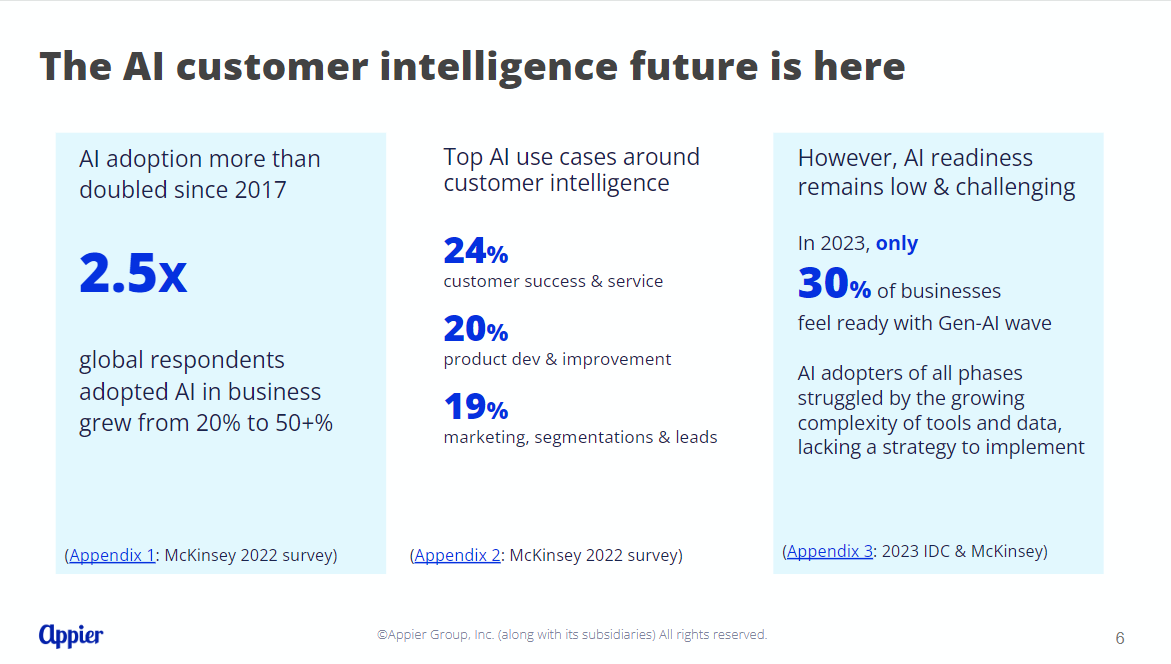
First, I want to quickly share some stats about AI adoption and demand. According to Mackenzie's 2022 and 2023 surveys, the adoption and use of AI have more than doubled since 2017.
The survey also points out that the top three areas with the most AI demand revolve around our topic today on customer insights and analytics.
The most popular AI use cases show that 24% of users surveyed were interested in using AI for customer success and service followed by 20% in product development and improvement, and 19% in marketing, segmentation, and leads.
As the use of AI continues to grow, most businesses are grappling with the escalating complexity of data.
Many find themselves challenged with selecting the best tools and strategies to embrace the emerging trend of AI insights. In fact, a survey from IDC showed that only 30% of businesses actually felt technically ready to ride the new wave of generative AI.
Next, we'll take a look at future trends in customer analytics at Woopra. As we see it, AI trends will bring accelerated growth with faster time to insight.
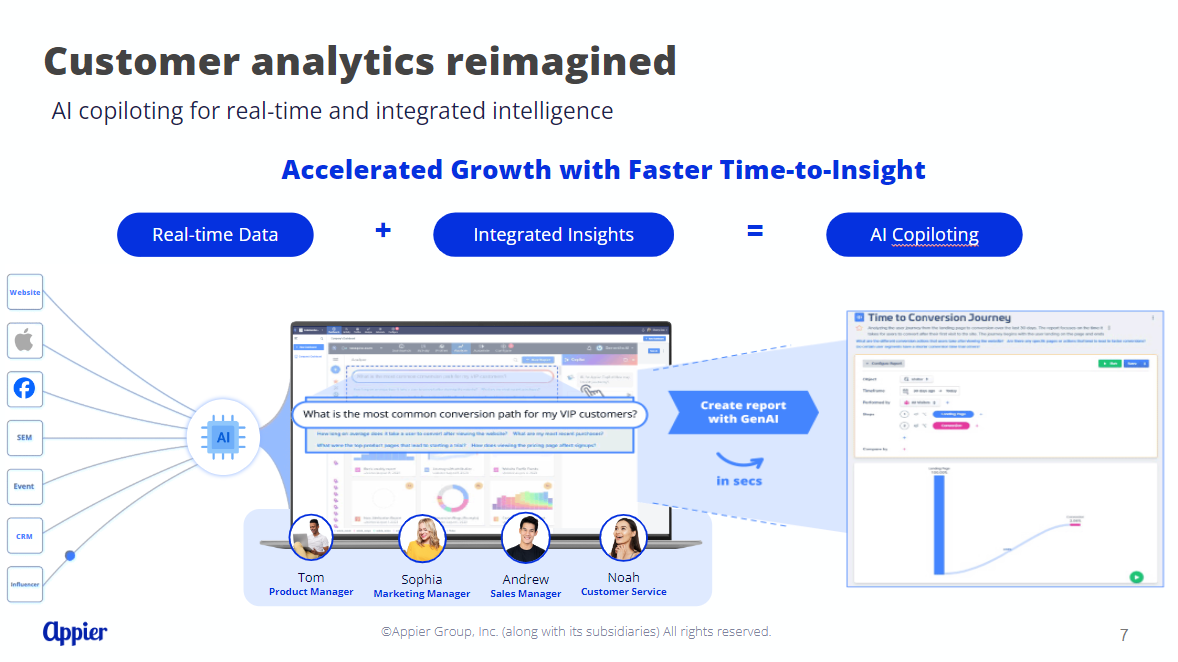
We continuously analyze AI feature trends and customer analytic needs to help build our product vision. We believe that the new generation of customer analytics needs to be built around three areas for client success.
First is the ability to bring disparate data together; to have a single source of truth. And also the ability to analyze that data in real-time.
Most companies today have data in several different places, such as online, offline, and even third-party applications. So being able to bring all of that data together really helps to understand the complete customer journey.
The second is to bring integrated insights to empower every team, such as customer success, sales, marketing, and product teams to optimize growth.
Lastly, utilizing AI-generated insights for growth and optimization at scale.
Over the past decade, I've had the pleasure of solving a wide range of problems with clients ranging from product teams, to marketing, customer success, and sales.
As a result, they often turn to us for collaboration and we work together to tackle unique, yet interconnected questions.
This partnership allows us to nurture growth through data-driven customer insights.
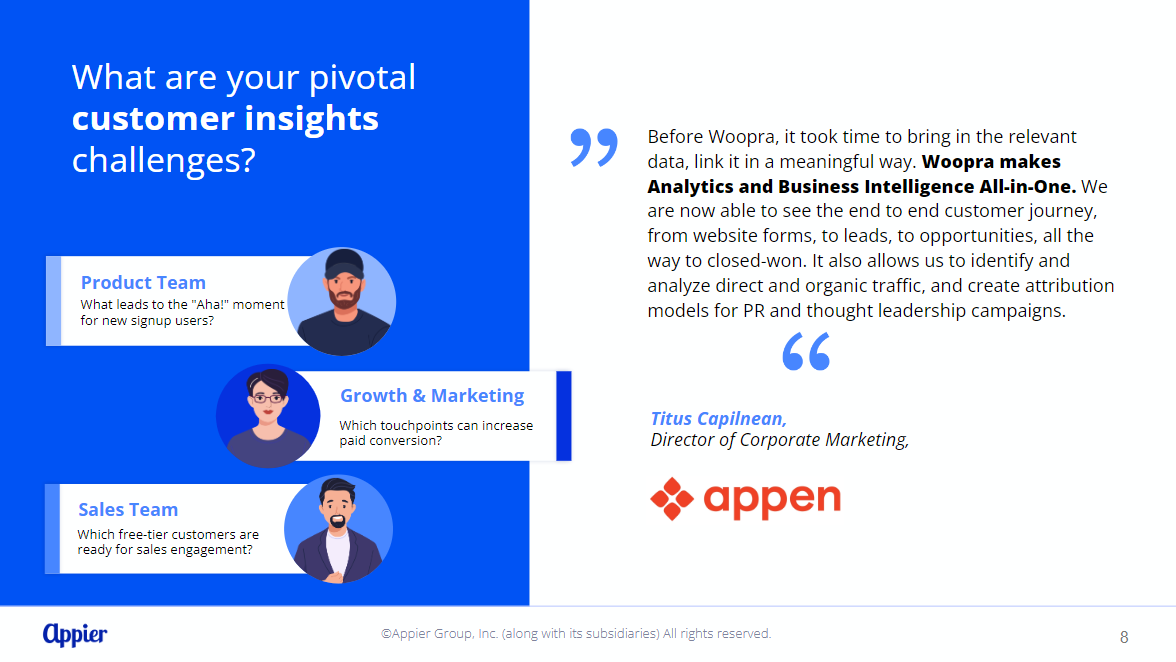
Like a product team, they might ask which product features high-value clients are using or marketing, or in other words, which marketing channels are driving the most conversions for sales teams.
With each team focusing on different areas, it's important to find the tool that can answer a wide range of questions to understand the complete end-to-end customer journey.
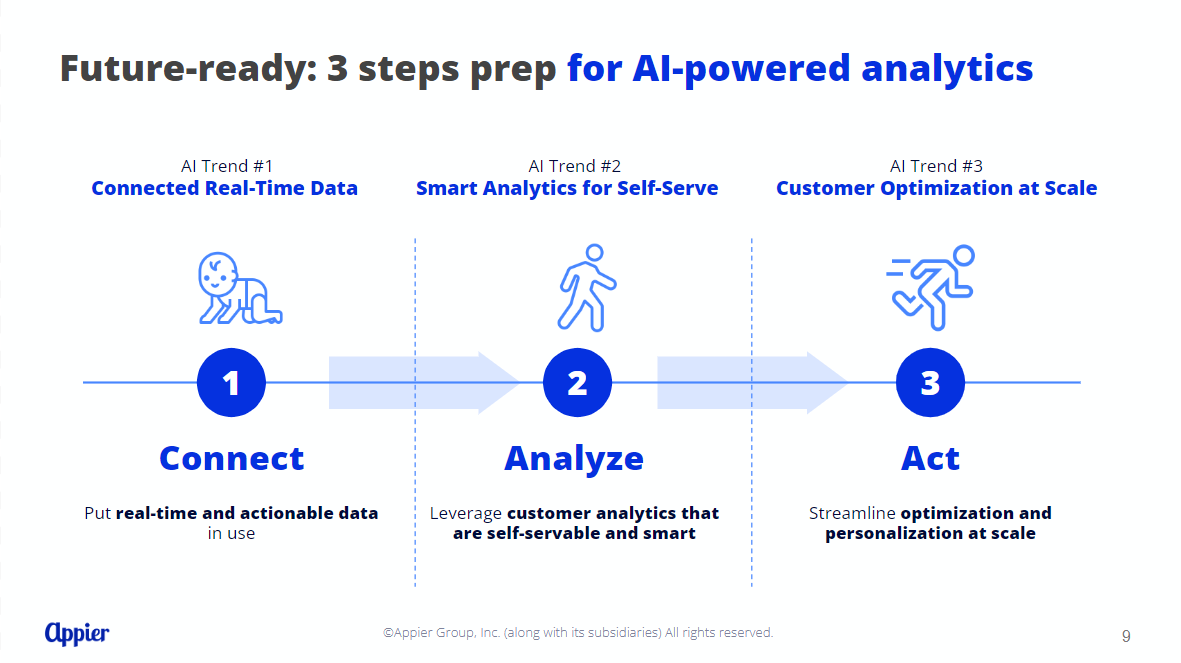
In the foreseeable future, AI is going to increase productivity in several areas when it comes to data analytics.
Customer journey decisions will become real-time and allow you to take the best action in milliseconds. What you invest in now will significantly impact future business decisions.
And it all starts by making the right choices in your infrastructure and tools in the following three areas. We'll help you unlock the AI power of customer analytics.
First, look at the various AI trends. Then look at real time data from across various sources. With the help of AI tracking, it is easier than ever.
For example, with intelligent AI auto-tagging, customized event tracking, which could take a developer several weeks to implement, can take seconds with AI.
Second is smart analytics and analyzing data with AI for self-service. The feature of AI-powered customer insights can help everyone on your team. It can even help both technical and non-technical users reach valuable insights with your data.
To compare, in the past, you might have needed a whole team to help answer questions. Now, we can simply ask AI to output an answer in seconds.
And lastly, number three is customer optimization at scale and the ability to act on data with AI. With that personalization of the product and growth, optimization is currently hard to drive at scale and can often take time and effort.
So with predicted and generative AI development, customer growth decisions and optimizations are streamlined and even automated to maximize ROI.
Setting Up for Success: Navigating Analytics Tools in the AI Era
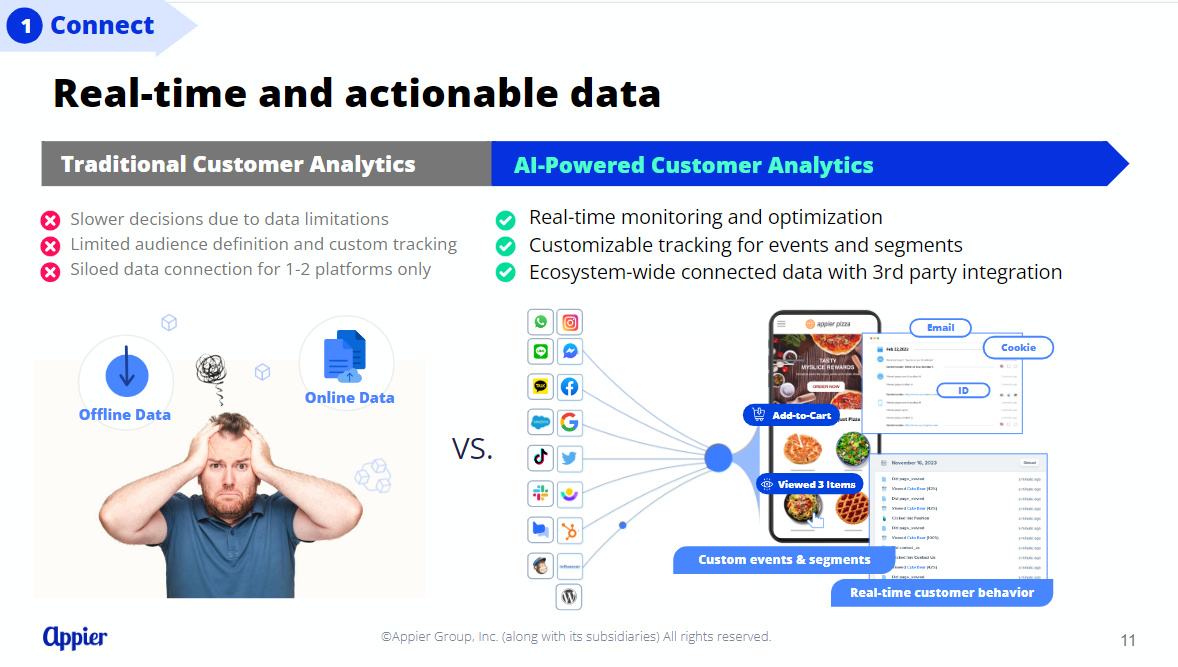
First, we mentioned connecting real-time and actionable data. Everything starts with data collection.
According to our clients and customer feedback from users who use traditional platforms, such as Google Analytics, they found that these tools were slow for decision-making due to incomplete data connections, limited networks, and a lack of or hard-to-find events or audiences.
AI needs to be real-time customizable and can integrate with data points across the customer journey. With real-time, data, sales, support teams, and marketing teams can all act faster to avoid missed opportunities.
We’ve all heard the saying, “Less is more.” But in data, I tend to lean more towards more is more. Businesses often don't know what they don't know, and you’ll find that tracking more data can often find and give you more insights that you haven't even thought of.
For example, the marketing team might only be interested in tracking the top-of-the-funnel events.
But if you track more data after someone becomes a customer you can start to segment these users as high-value or low-value clients. This can give you insights into which marketing campaigns are driving the most high-value clients.
This insight could be incredibly valuable for bargaining teams which you could miss out on if you're only tracking the top-of-the-funnel analysis.
The heart of the total power of AI customer analytics is tracking the complete customer journey, which requires real-time monitoring and optimization.
The ability to track custom events with audience segmentation and the capacity to connect with third-party integrations and external data sources is self-serviceable and smart analytics.
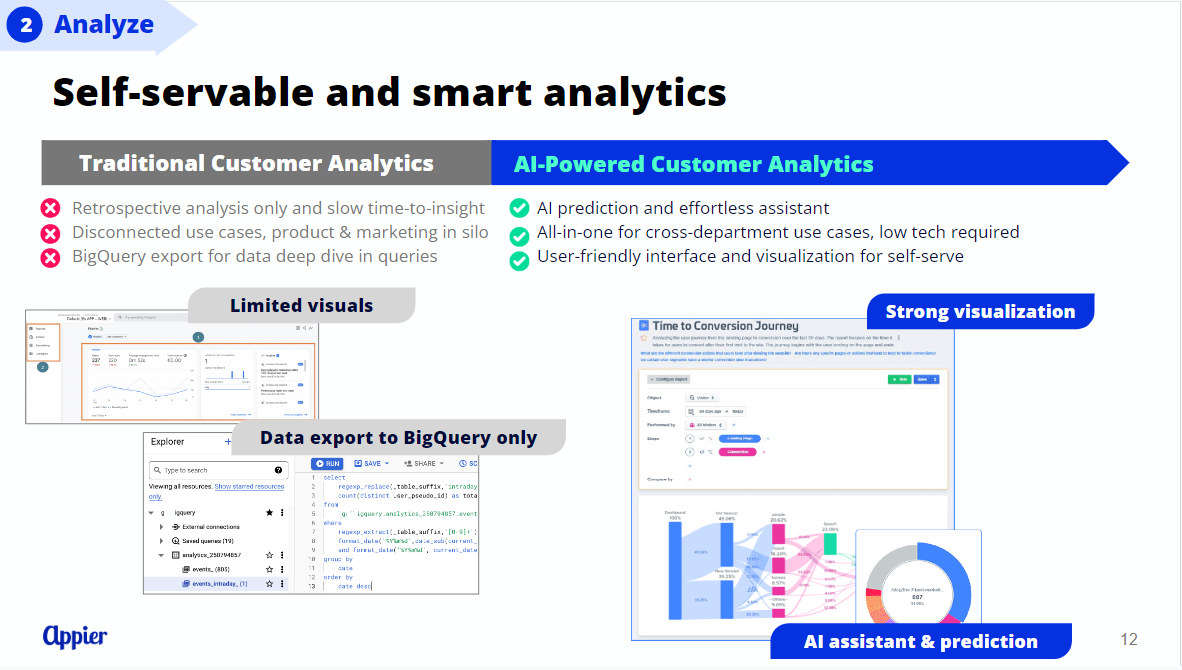
With the growing trend of being able to self-serve, you want to find a platform that empowers everyone on your team to get answers. Traditional customer analytics can only show reports on a small part of your customer journey and provides a slow time to insight.
Often if you want to deep dive into that data, you still have to export that data to a database and then run complex sequel queries to gain any kind of insight.
So with AI-powered analytics, it'd be great to have AI features providing predictive insights that can allow you to analyze the complete customer journey without any technical expertise by simply asking natural language questions about your data.
Also, look for a user-friendly interface that allows cross-department teams to get immediate answers and solve your business problems.
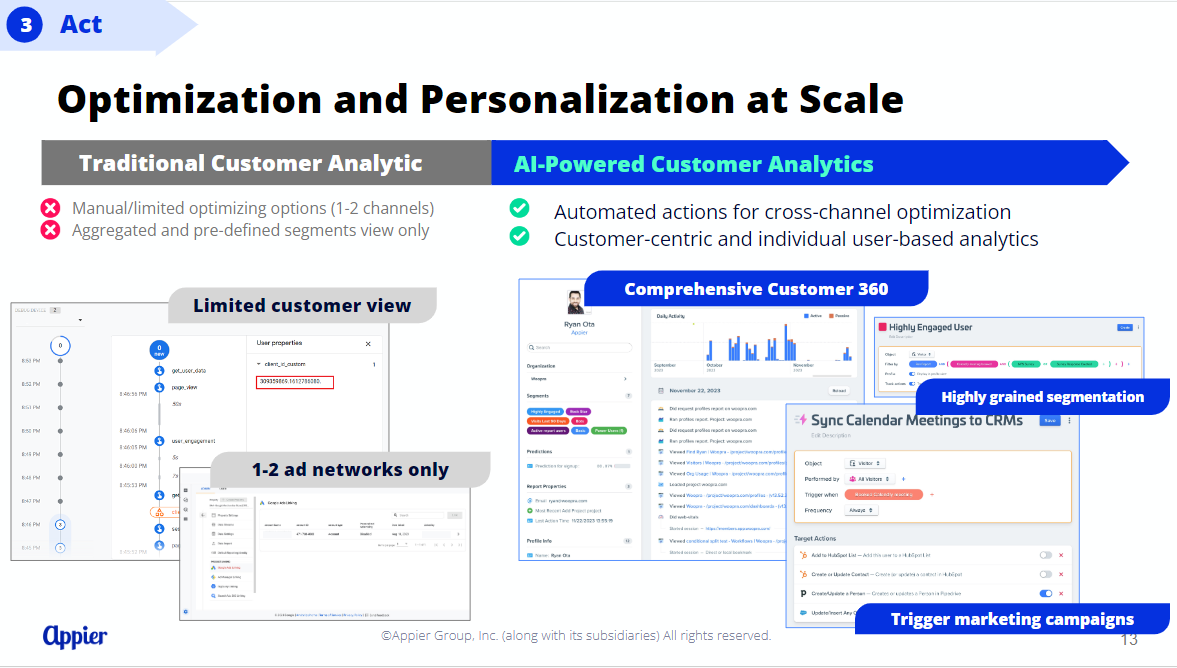
Number three is how you can act on your data through optimization and personalization at scale.
Traditional customer analytics only provide limited channels, which have limited options for customer journey optimizations with your product and often have limited segmentation options and less profile visibility.
With AI-powered analytics, it's important to find a tool that can automate actions for cross-marketing channel optimization with the ability to customize granular audience segmentation for product or marketing personalization.
It boils down to finding the right tool that can take immediate action, seize opportunities with the ability to define specific audiences, and target leads through multiple channels.

To summarize, choosing a tool that can connect, analyze, and act on your data will be vital to gaining the most value from AI-powered analytics.
With a connection that focuses on real-time data with third-party data in integrations and custom tracking and segmentation, clients can analyze AI predictions and efficiently copilot for all-in-one customer analytics and user-friendly visualized data.
Introducing Woopra: Case Studies and Demo
Woopra is an AI-powered, customer analytic platform that enables businesses to understand the complete user journey of customers. With Woopra, we can predict high-profile customers and make the most informed data-driven decisions.
Woopra can answer a wide range of questions to help maximize ROI. Here are four typical questions businesses may ask.
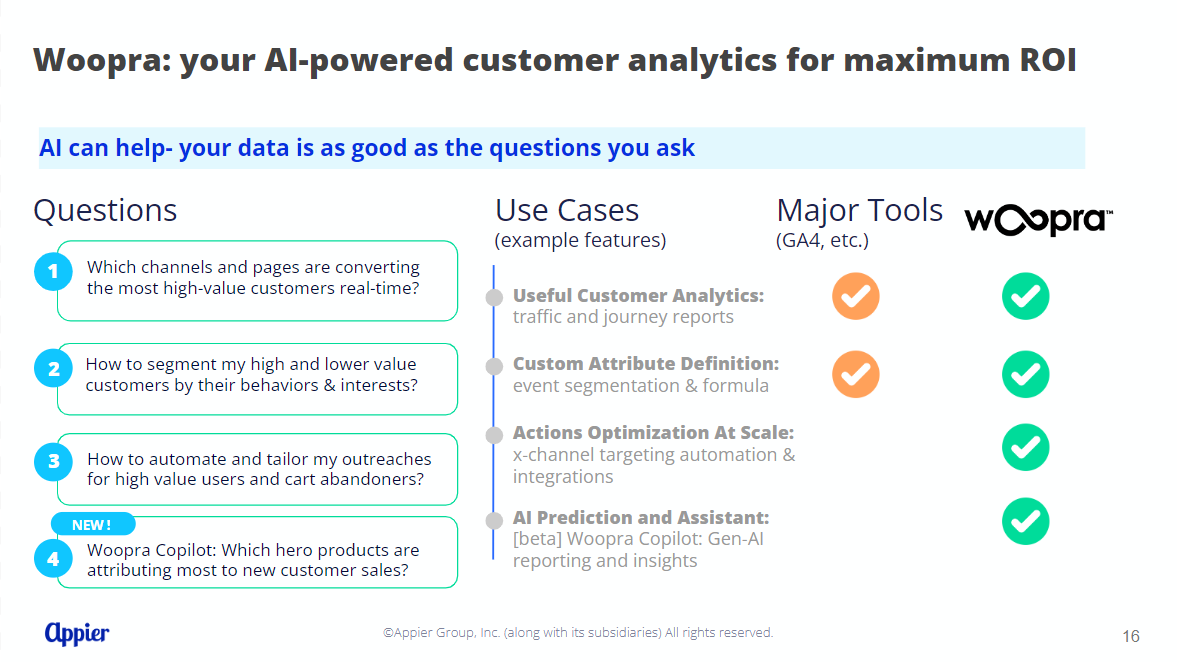
Which channels and pages are converting the most high-value customers in real-time?
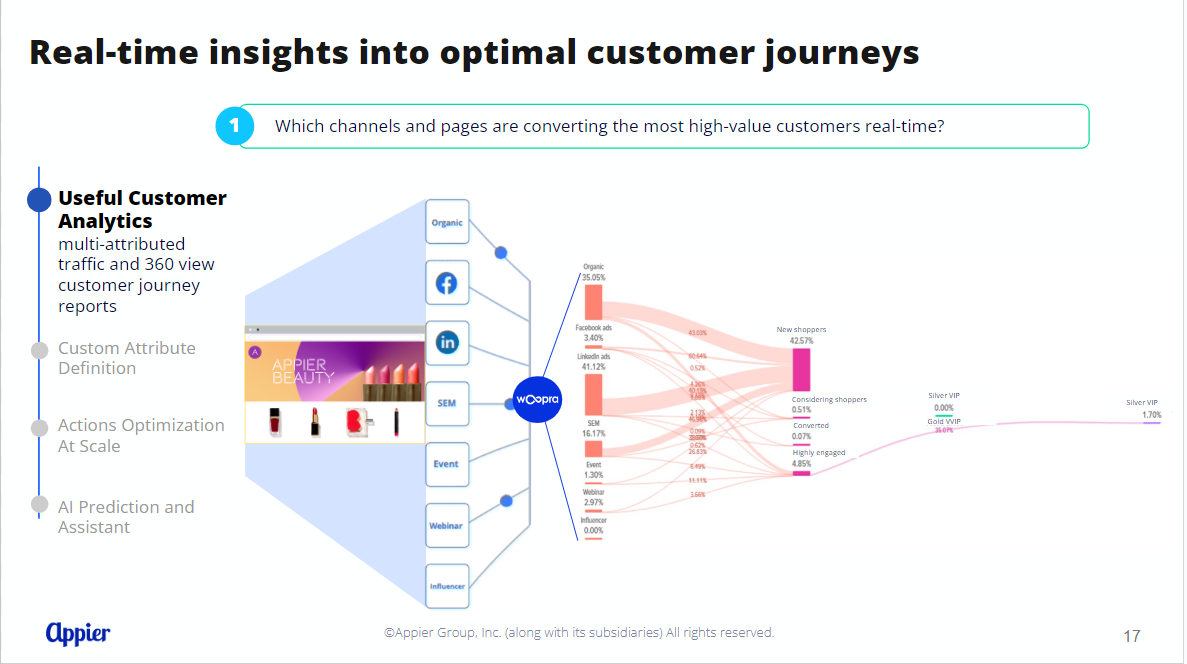
How do I segment my high and low-value customers by their behaviors and interests?
How do I automate and tailor my outreach for high-value users and cart abandoners?
And which hero products are attributing most to new customer sales?
While some other tools might focus just on tracking, Woopra expands on what's possible with track data by allowing you to answer complex questions and act on that track data.
So let's dive a little deeper, and see how Woopra can be applied to these various questions.
Looking at real-time, insights into optimal customer journeys can analyze the complete user journey from how they're getting to your site to which channels are working the best to how they're interacting with your product.
And finally, looking at what's driving those conversions and continued product usage as soon as a user does something on your site. With the Woopra profile, it is instantly updated. This allows teams across your organization to act instantly.
One of our clients has a subscription model for the commodity industry, and Woopra empowers their sales teams by giving them instant access to insights about those potential clients.
They can then track things like which marketing channels are bringing in the most visitors, which articles are being viewed the most, and how long they are staying on each page.
They can even look at automating email outreach to potential clients based on customer segments focused on high-value potential leads.
The emails are also customized to include the articles that their leads are interested in, based on all the data that they're tracking in Woopra after they send the automated emails out.
They can even track these emails and see who's coming back. Once they return, they have another automation in Woopra that updates the slack channel for their sales teams to be instantly notified when the high-value lead returns.
This type of holistic tracking and automation has greatly increased their conversion rates by allowing their sales team to act fast and to focus more time on high-value leads and less time on sending out blind emails.
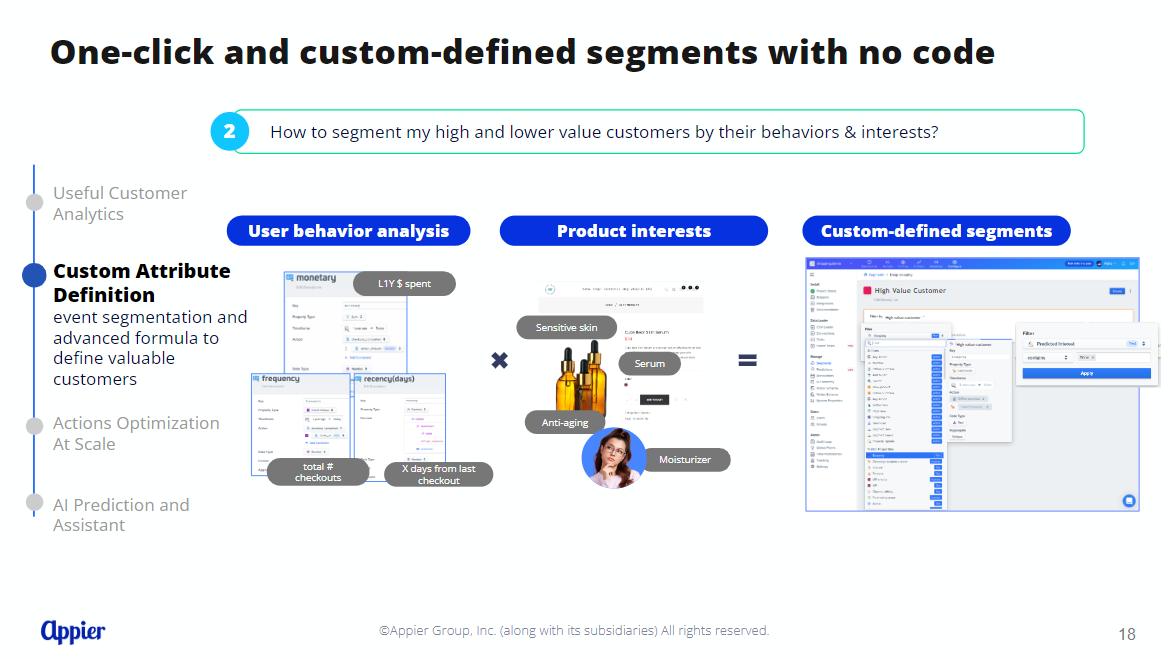
How do I segment my high and low-value customers by their behaviors and interest?
With our segmentation feature, we can use formulas and extremely granular filters to define any number of custom segments or audiences based on user activity.
These segments don't require any code and they could be easily made by non-technical members in minutes.
These segments allow for a wide range of actionable insights.
I helped one of our clients, who provides lessons and certifications for digital marketers, to create a complete scoring model for their users.
Using formulas, we were able to assign points based on a wide range of activities that their clients could do on their site. Such as five points for completing a lesson or 10 points for getting certified.
Next, we created custom metrics that updated the totals for each user in real-time. Then, based on these scores, we were able to bucket these users into different segments, such as high, medium, and low-value clients.
The clients then were able to track which lessons or activities were driving the most engagement and automate content and outreach based on the user activities.
Now they can customize segments which allows them to better understand their users’ behaviors and help their product teams focus on lessons and content that drive the most engagements.

Let’s next look at how to automate and tailor my outreach for high-value users versus cart abandoners.
I've touched on some of these user cases previously. But I'll expand on Woopra's automation features. We can create a complete workflow based on user behaviors.
A user may enter an automated workflow by adding an item to a cart and then we can select the timeout period if they don't complete the purchase. We can then use our integration to send an automated email to that user.
One of our clients that heavily uses this feature is an airline business that we work with. They use our automated workflows to send out customized emails to those users who check out, and they also have workflows for users who abandon their carts.
These workflows pull in data tracked from their user selections such as seat preferences or how many travelers to and from destinations and estimated departure times.
All of this data is tracked in their Woopra instance. And they use this data to inject this information into customized emails that they send out with our send grid integration.
For their current abandonment workflow, if a user enters all their flight deal details but ends up not checking out, they can actually customize an email outreach that injects all the flight details in the automated email to try and regain potential conversions.
With Woopra, they can do a random AV test with our automation that tries different email formats when sending these current abandonment emails and then track their performance as well.
Tracking data is one side of the point. The other side is being able to act on that track data.
There's a wide range of possibilities to help increase engagement and revenues with Woopra’s newest feature and development: Our AI Woopra Co-Pilot.
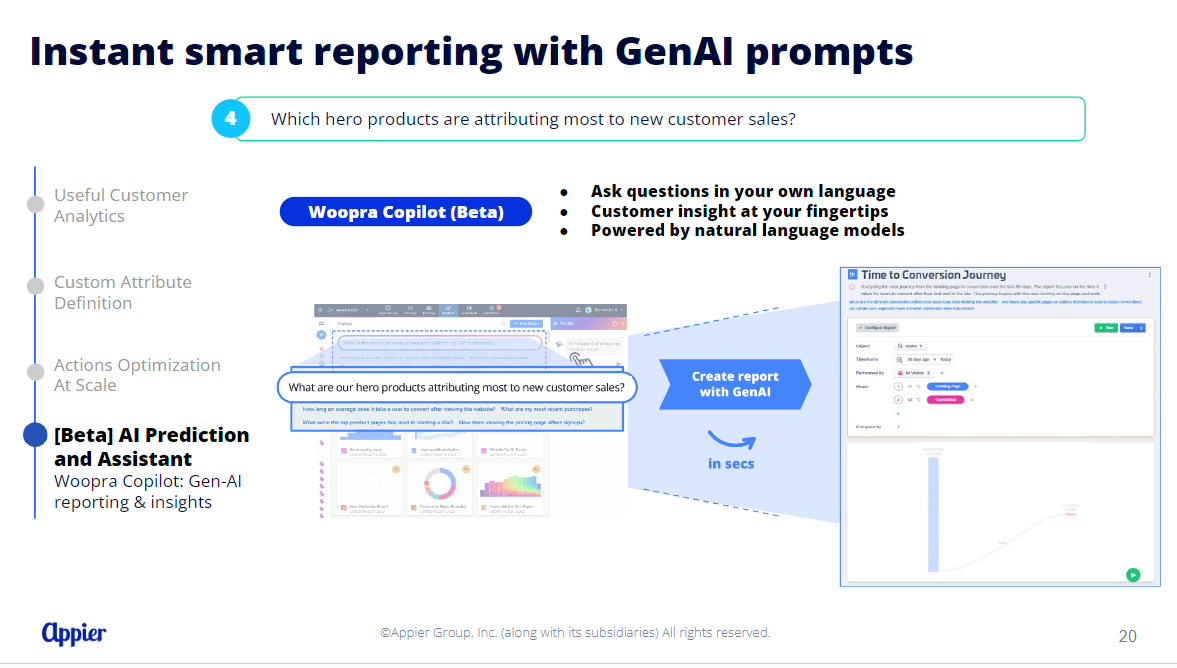
We can ask natural language questions and copilot, then automatically select and configure the report to provide you with the answers you need.
This feature aims to get to the quickest answers possible without needing to manually build a report. This would allow anyone on your team to gain valuable insights and seconds without having to rely on an in-house data expert.
Reach out for a Demo of Woopra Copilot: Gen-AI reporting and insights.


